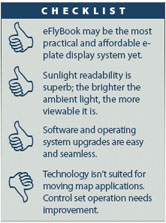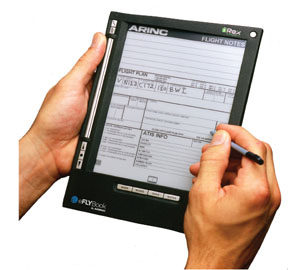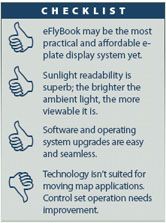Like most p
Flying behind a glass panel, Im no stranger to electronic chart systems. These have proven less than optimal, however. Running a chart program on a tablet computer is no picnic in the cockpit. Its awkward and can be risky in turbulence and there’s always the chance of a disc crash at high altitude.

Avidyne has a solution for the Columbia in the form of the CMAX chart system, which runs on the Entegras MFD, but I just don’t see good value in $3000 for that system, plus $900 for annual chart revisions.
So when ARINC rolled out the eFlyBook earlier this year, it looked like the perfect solution. Small, simple and easy-to-use access to approach plates and other documents. While its a good start toward a practical, readable and affordable way of managing approach plates electronically, its still not quite the perfect solution.
Digital Paper
The iLiad is about the size and weight of four iPods arranged in a rectangle and it fits comfortably in the hand or Velcrod to a kneeboard. The high-resolution (728 by 1024 pixels) screen area is just slightly smaller than a standard NOAA approach chart.
And unlike most computers, the brighter the sunlight, the easier it is to read, since it uses an entirely different technology in which screen contrast improves with additional light. You can also point to and write on the screen using a PDA-like stylus. In short, the manufacturer calls it digital paper and thats an apt description. One sales person we talked to said it reminded him of a high-tech Etch-A-Sketch. The iLiad has no keyboard and only a few buttons: Back, Menu, Up, Down, Select, the page “flipper” and four selection keys for News, Books, Docs and Notes. From the off position, it takes about a minute to boot up and another minute to select the desired document: a SID, STAR, approach plate, airport diagram or the Take-Off and Alternate Minimums for a particular airport.

If youre used to laptop speeds, this device will seem slow when you have to peck out an airport identifier with the stylus on a keyboard icon, but thats the only data entry required other than pointing to selections. The built-in buttons allow some selections by pointing, but don’t seem to work at the detailed level when choosing among charts, approaches, SIDS and STARS. For that, you need the stylus.
The iLiad is 100 percent solid-state with no moving parts, so altitude wont affect it much. The eFlyBook software and databases are stored on a removable 512MB secure digital (SD) card the size of a postage stamp and widely used in many digital cameras. To update the card, you need either a wireless connection or an SD card slot in your PC. However, if you don’t have either of those, you can buy a USB-to-SD adapter for under $25 in the camera department at almost any electronics store.
Flying It
The unit comes with a small 12-volt power cube and a miniature travel hub so you can create a wired Ethernet or USB connection as well. The internal battery is sealed and must be charged externally. Mine lasted just under seven hours on a full charge with light use.
Apparently, the iLiad consumes little power while displaying a static image and slightly more power when changing images or when the stylus is out of its storage slot. If you want inflight power, you’ll need to find a 12-volt converter that fits into the type of socket you have in your airplane, although taking advantage of the long battery life with cordless operation seems preferable in the cockpit. A drained battery takes two hours to fully charge.
OK, so the thing is cute, but can it fly? I found that using the eFlyBook was similar to using a paper approach chart clipped to a kneeboard. It was easier to manage than struggling to hold open a bound NACO approach book or fly an approach on the screen of my 4-pound tablet computer. And while you can use the stylus to enter handwritten notes and fill in flight plans or logs on separate pages, you cannot mark up charts. Handwriting aloft is just cumbersome enough that most pilots will probably find it easier to use real paper for notes.
Currently, an approach chart is almost the same size as its NACO paper counterpart and almost fits on the screen. Either the top or bottom half-inch are scrolled off screen, but a quick swipe of the stylus moves the page up or down to bring those items into view. The software developer
plans to revise the icon area at the bottom in an upcoming version, so its likely the entire plate will soon fit on the screen. I found it quite readable in normal daytime conditions. And just like real paper, you’ll need external lighting for low-light or night operations. But unlike real paper, glare can be a problem with forward sunlight unless you can hold the eFlyBook at a different angle to knock back the glare.
Caveats
Three important caveats: First, youd better have a spare stylus close at hand. The last thing you need when flying an approach is to drop a tiny stylus thats your only ticket to the 13,500 stored approaches. you’ll need it to type in the airport identifier letters; fingernails wont substitute.
Second, its quite easy to press one of the buttons accidentally and suddenly find yourself reading Jane Eyre rather than ILS 22R. Depending on which button you inadvertently bump, you’ll need at least 30 to 60 seconds to retrieve your chart during an approach.
For example, accidentally pressing the iLiads operating system update button is easy to do when you pick up the unit with your right hand. In the airplane, it will launch a futile attempt to reach the iRex server, a potentially catastrophic event while youre flying an actual approach in weather. The latest software update partially remedies this by disabling some buttons while an approach chart is displayed, but other buttons still send you to places you don’t want to go. There needs to be a way to lock the approach chart on the screen once you have selected it. The developer plans to remedy this in the future. Last, portions of the Take-Off Minimums, Alternates, and some SIDS and STARS use a light-gray font thats virtually illegible. That will need to be fixed if the eFlyBook is to ever replace paper.
Electronic Updates
With the eFlyBook, you receive two companion programs for your PC. The first program manages the IFR database updates and checks for chart currency once a day. If it finds newer charts, it downloads them to your PC, where youre responsible for copying the updated file folders onto the SD card. Mercifully, the latest software revision now permits the entire IFR aviation database to be downloaded and transferred to the SD card in minutes rather than hours. A second standalone program allows you to display and print a paper copy of any approach chart in the database.
In addition to the IFR databases, two other types of updates are possible. To update the built-in proprietary iLiad operating system-which is invisible to the user, as in a cell phone-you simply connect to the internet with an Ethernet cable and press the update button. As long as you have registered your iLiad with the manufacturer, the process of checking for operating system updates and installing them is automatic and transparent. It takes less than five minutes. In my opinion, this is an elegant way to handle operating system updates.
The other kind of optional update allows you to manage your own document portfolio using the supplied USB cable. When you connect your iLiad to your PC, the user-accessible storage on the iLiad simply looks like an external disk drive attached to your PC. Youre free to copy files back and forth between the two units. Alternatively, you may transfer documents using an inexpensive USB memory stick or wireless network.
Currently, the Hi- and Lo-altitude enroute charts have no zoom ability, so theyre not functional at all. you’ll still need paper enroute charts. However, future updates are supposed to include the zoom feature, the indexed text of the FAR/AIM and the nationwide Airport/Facility Directory indexed by airport identifier. Update subscriptions cost $289 a year and the purchase price includes a year of updates.
Vendor Support
MyAirplane.com is a small company and its clear that the support personnel are scrambling to respond to customer issues following eFlyBooks introduction last summer. I had to make several calls to resolve problems with software registration and lockups, which have disappeared since the latest software update.
The three different people I spoke with on these occasions worked hard to get me the information and updates needed. Early teething problems are typical of new technologies, but I suspect this product could have used another round of Beta testing and software revisions before public release. However, with ARINCs support behind this product, it should be refined in due course.
The Verdict Please
The eFlyBook occupies a niche that has been an elusive one to fill. Subject to the button and stylus caveats expressed earlier, I think it represents a practical way to maintain IFR approach information in a small device you can hold in one hand. No, its not geo-referenced like its more expensive panel-mounted cousins, so don’t expect to see an icon of your airplane flying across the iLiad screen. The technology just isn’t capable of that. You will still need a separate PC to handle the updating and printing chores at home. And purchasers will have to carry paper sectional charts and wait a bit for the eFlyBooks enroute charts, A/FD and FAR/AIM features to be completed.
But if all this little device does is let me hold and display the entire U.S. approach chart database in one hand, I consider my $1199 (plus shipping) we’ll spent. Oh, and I still carry my box of charts. I just don’t expect to use them much, if at all.
Rudy Engholm is a 3400-hour Columbia 400 pilot. He lives in Maine and is a board member of Lighthawk, a volunteer environmental flying organization.





